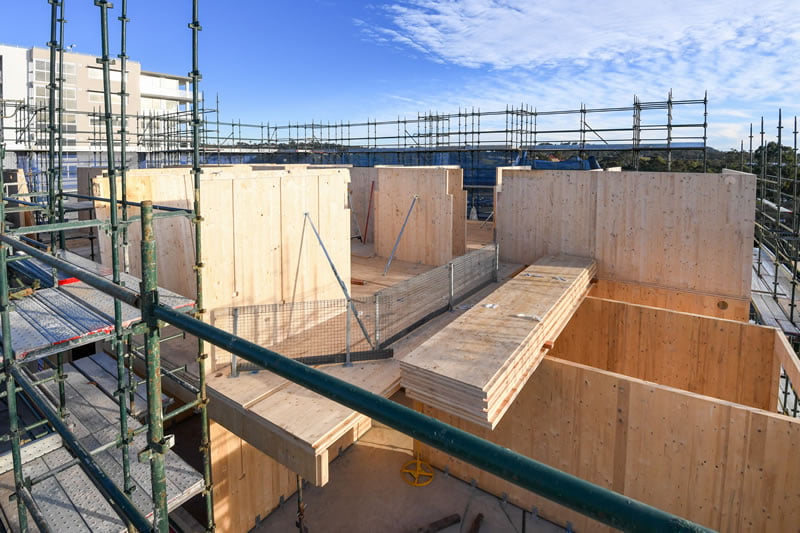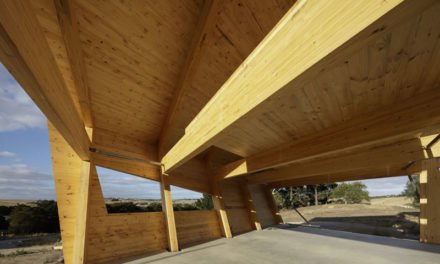Timberlink has announced a new CLT and GLT manufacturing plant in SA or Vic.
With mass timber carving out an ever-increasing market in Australian construction, it’s the ideal time for more local production. Leading timber producer Timberlink is taking on the challenge with its board approving plans to build a new state-of-the-art Cross Laminated Timber (CLT) and Glue Laminated Timber (GLT or glulam) manufacturing facility.
“It’s pretty exciting for us,” says Timberlink CEO Ian Tyson. “This move represents the second stage of our long-term plan. We’ve invested heavily in our mills and got them to an international standard and now we’re looking at how to add all the value components to that investment. Moving into CLT and GLT production is another step towards becoming a world-class, sustainable business that’s able to make optimal use of our wood fibre and all its carbon storage and buildability advantages.”
The decision follows extensive research into the global wood products market, as well as a close look at fibre use from Timberlink’s own production.
“We formed a view that the global mass timber market still had a long way to go – especially in Australia,” says Tyson. “There’s plenty of opportunity for another party to be involved in that, given how much we currently import.
“We think the service levels and the complexity of the product are such that local supply is the best way to grow the market.”
In terms of fibre use, the facility is a continuation of Timberlink’s commitment to get the best value out of its wood product. “Timber is a precious resource and we need to add every bit of value we can to it,” Tyson says. “The fibre that is used in engineered timber products isn’t necessarily the same fibre that you’re putting into house framing. Rather than competing for the resource, we’re getting a better utilisation of some of the less desirable fibre and some of the lengths of product that are also less desired in the market. Through the manufacturing process, we can finger-joint them and use them in panels.
“It’s not taking from one market and putting in another, it’s actually expanding the market size and creating a valuable product out of something that has traditionally been less in demand.”
In recent years, Timberlink has upgraded its Australian mills, producing more volume. The new facility will increase the amount of fibre going into quality product and will lock up carbon in building stock over the long term.
Championing innovation
Locations for the facility are being scouted in South Australia and Victoria, with both state governments and the federal government involved in discussions. The plant will create 27 full-time permanent jobs on opening in 2023, rising to 50 at full output. A significant number of additional jobs will be created during the construction phase.
Government engagement at the planning stage makes a lot of sense, Tyson says: “Both state governments and the federal government have been heavily focused on innovation for industry – particularly in the wood products industry. Here we have the perfect example of a major investment in innovation. Early on, we’ve said to them, ‘Well how can you partner with us?’
“It’s not just about money, it’s actually thinking about the whole innovation journey, seeking their input on how we can gain the most advantage and what role government can play in that. Though finances do play a part. There is a fairly long payback on a project like this and if government’s able to assist, then it will A: help the project to be more successful, and B: probably help it to be more financially attractive.”
In addition to the obvious employment benefits of the facility, Tyson flags that it will play an important role in driving the growth of mass timber construction in Australia.
“The FWPA has done an enormous amount of work in this sector,” he says. “The Mid-Rise Advisory group has been out there talking to specifiers and architects and driving projects – and we’ve been a part of that right from the beginning. This is our fourth year of investment, even though we weren’t in the category when we began.”
While the market share of CLT and GLT is growing steadily, about half is still imported from Europe and North America, even though there are several successful Australian producers. Issues with delays, currency fluctuation and education are just a few of the problems that disappear with local manufacture, but as important is the security of expert local service and supply.
“The reality is that the more people that are out there, the more support the product gets,” says Tyson. “Having another major player in the market to expand the penetration, to open more doors, to provide more training and development – and all those things are part of our plan – will both grow the market and also accelerate the growth of the market.”
The Timberlink facility will be Australia’s second major softwood CLT plant and first combined CLT and GLT manufacturing facility.
For more, visit timberlinkaustralia.com.au












